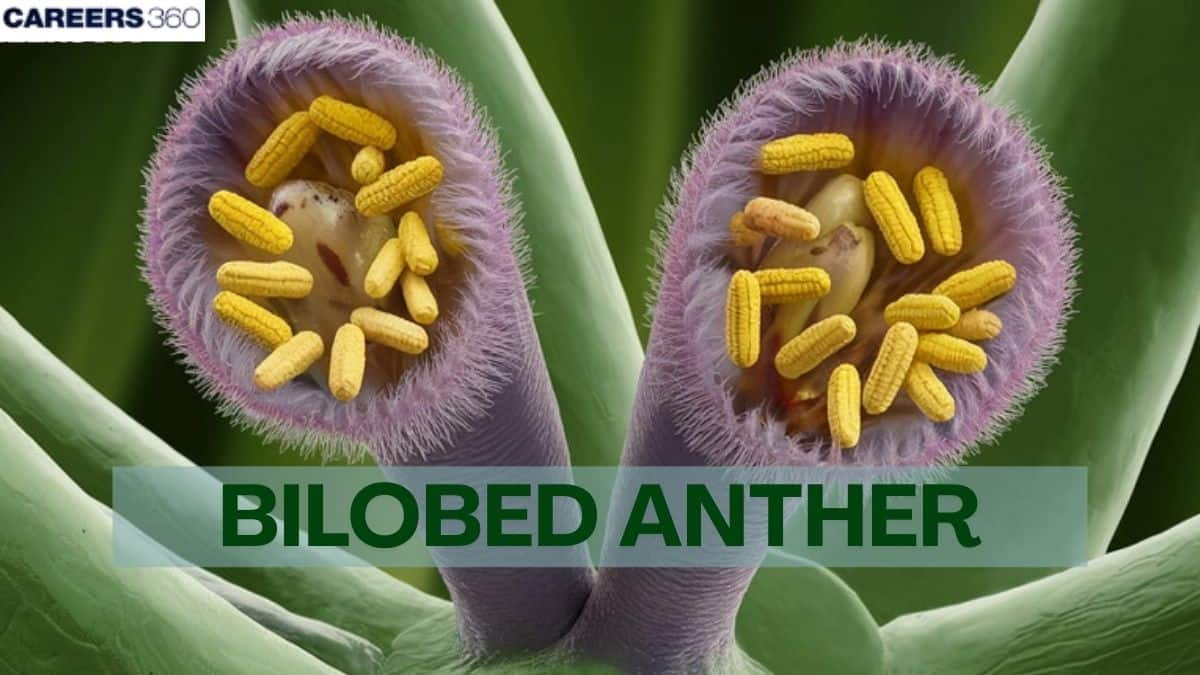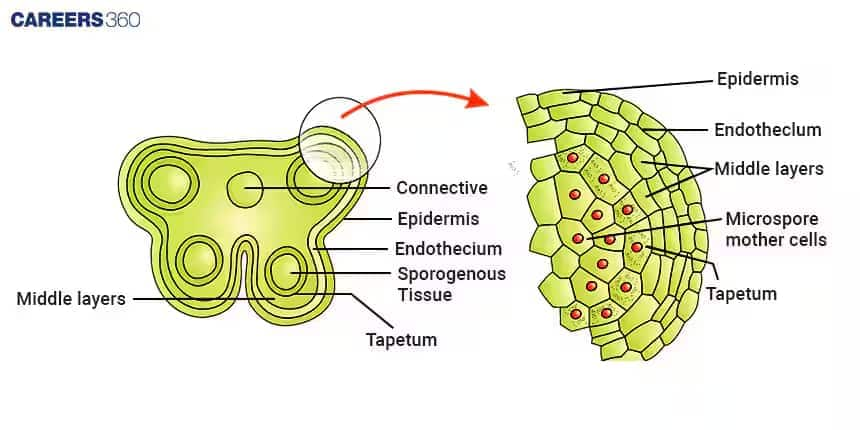Bilobed Anther
Floral organs consist of sepals, petals, stamens, and carpels. A stamen consists of a stalk called the filament and a terminal structure called the anther. A bilobed anther, divided into two lobes, is the male reproductive part of a flower responsible for producing and releasing pollen grains. Within each lobes of the anther are chambers called microsporangia (pollen sacs) that produce pollen. Each lobe contains two microsporangia and a bilobed anther contains four microsporangia, also known as pollen sacs. Within the microsporangia are many diploid cells called microsporocytes which undergo meiosis, forming four haploid microspores, each of which eventually gives rise to a haploid male gametophyte.
This Story also Contains
- What is Bilobed Anther?
- Structure of an Anther
- Transverse Section of Anther
- Microsporangia and Microsporogenesis
- Thecae and Connective Tissue
- Importance of bilobed structure in pollen release
- Bilobed Anther NEET MCQs
- FAQs on Bilobed Anther
- Recommended Video on Bilobed Anther

A bilobed anther is the male reproductive part of a flower responsible for producing and releasing pollen grains. Each lobe contains two microsporangia where microsporogenesis occurs. This unique structure ensures efficient pollen storage, dispersal, and successful pollination in flowering plants. This topic is explained under the Class 12 chapter Sexual Reproduction in Flowering Plants of Biology. This article includes the structure of anther, diagrammatic representation and related concepts like microsporangia and pollen formation.
What is Bilobed Anther?
The anther is a part of the stamen. It is the organ for the production and storage of pollen grains in flowering plants. Anthers are concerned with pollen transfer from one flower to another and, in turn, fertilisation in plant reproduction. One bilobed anther consists of two distinct lobes, each lobe containing pollen sacs. This structure allows for maximum dispersal of pollen grains and thus offers a chance for successful pollination and an increase in the genetic diversity of plants.
Structure of an Anther
The anther is that part of the stamen that bears pollen, and it is usually bilobed with two pollen sacs or microsporangia within each lobe. The structure of the anther is described below:

Two lobes of Anther
Within an anther, two lobes are connected using connective tissue. Each lobe is further subdivided into two microsporangia.
Epidermis
It is the outer protective layer of the anther that protects the inner tissues from the harsh conditions of the environment.
Endothecium
This layer is just inside the epidermis, which supplies the force for anther dehiscence or opening, hence releasing the pollen.
Middle layers
It consists of a few layers of cells which help in providing structure support and also participate in the maturation of anther.
Tapetum
This is the innermost single layer lining the anther wall that supplies nutrients to the developing pollen grains.
Transverse Section of Anther
The transverse section of anther is explained below-
The epidermis is the outermost protective layer of the anther.
The endothecium lies just beneath the epidermis and helps in the dehiscence of the anther by developing fibrous thickening.
There are 1-3 layers beneath the endothecium, which degenerate during pollen maturation.
The tapetum is the innermost nutritive layer, which surrounds the microsporangia and is rich in cytoplasm and provides nourishment to developing pollen.
The microspore has four pollen sacs, two in each theca, where microspore mother cells undergo meiosis to form microspores.
The central sterile tissue, which is the connective tissue, joins the two thecae and contains vascular bundles for nutrient supply.
Microsporangia and Microsporogenesis
Microsporangia are the pollen sacs in the anther, inside which microsporogenesis takes place for the formulation of microspores. Each lobe contains two microsporangia and a bilobed anther contains four microsporangia, also known as pollen sacs.
Microsporogenesis is the process in which a diploid microsporocyte undergoes meiosis to yield haploid microspores. Within the microsporangia are many diploid cells called microsporocytes, or microspore mother cells. Each microsporocyte undergoes meiosis, forming four haploid microspores, each of which eventually gives rise to a haploid male gametophyte. Each microspore then undergoes mitosis, producing a male gametophyte consisting of only two cells: the generative cell and the tube cell. After the microsporangium breaks open and releases the pollen, a pollen grain may be transferred to a receptive surface of a stigma.
Thecae and Connective Tissue
These anther lobes are further divided into two thecae, which act as the chambers for storing pollen. The thecae will ensure the pollen is kept safe up to when it would have matured to be dispersed.
Connective tissue forms the centre of the anther, joining the two lobes together and containing vascular tissues that feed the anther.
Importance of bilobed structure in pollen release
The bilobed anther has a specific structure that has importance in:
Increased Capacity and Storage: Since a bilobed anther contains a total of four pollen sacs, it greatly increases the number of pollen grains produced and stored.
Enhanced Pollination: The bilobed structure is specifically designed to let the pollen grains disperse from the anther for fertilisation.
Dehiscence: After the maturation of pollen grains, the anther undergoes dehiscence, where it splits open to release the pollen for pollination.
Bilobed Anther NEET MCQs
Q1. Which of the following statements is incorrect?
The endothecium, which has thin walls and creates the stomium or line of dehiscence of the anther, is situated between the two microsporangia in one anther lobe.
The pollen grains and growing microspore mother cells are fed by tapetum.
Nutrients and thick protoplasm are both present in the tapetum's cells.
The epidermal cells become thicker and more fibrous.
Correct answer: 4) The epidermal cells become thicker and more fibrous
Explanation:
D. The correct statement is endothecium cells become thicker and more fibrous. The epidermis, which has a single layer of cells, is the top layer of an anther from a flowering plant. The epidermis is in charge of guarding the anther's internal tissues. The epidermal cells do not, however, thicken and grow more fibrous as the anther develops.
Explanation for the incorrect options :
Option 1 is incorrect because, in one anther lobe, there is a layer of cells called the endothecium that is situated between the two microsporangia. It produces the stomium, or line of anther dehiscence, and has thin walls.
Option 2 is incorrect because the tapetum provides food for the pollen grains and developing microspore mother cells. The growing pollen grains receive nourishment from the tapetum, a layer of cells that surrounds the microsporangia.
Option 3 is incorrect because the growth of the pollen grains depends on the presence of nutrients and thick protoplasm in the tapetum's cells.
Hence, the correct answer is option 4) The epidermal cells become thicker and more fibrous.
Q2. The layers of microsporangium are in correct order from inside to outside.
Endothecium , Tapetum , Middle layer , Epidermis
Epidermis , Endothecium , Middle layer , Tapetum
Tapetum , Middle layer , Endothecium , Epidermis
Tapetum , Endothecium , Middle layer , Epidermis
Correct answer: 3) Tapetum , Middle layer , Endothecium , Epidermis
Explanation:
The layers of a microsporangium are sequentially arranged as follows:
1. Tapetum: Primary nourishing layer for the developing pollen grains. Highly metabolically active with multiple nuclei.
2. Middle Layers: Composed of 2-3 parenchymatous cell layers that degrade with microsporangium maturation.
3. Endothecium: Positioned outside the middle layers, it assists in anther dehiscence. Characterised by fibrous reinforcements.
4. Epidermis: The protective outermost layer. Generally persists as a covering on the anther.
Hence, the correct answer is option 3. Tapetum , Middle layer , Endothecium , Epidermis
Q3. The microsporangia develop and become:
Microspore
Pollen grain
Sporoderm
Pollen sac
Correct answer: 4) Pollen Sac
Explanation:
The anther is a four-sided structure consisting of four microsporangia located at the corners two in each lobe. The microsporangia develop further and become pollen sacs. They extend longitudinally all through the length of an anther and are packed with pollen grains.
Hence, the correct answer is Option (4) Pollen sac.
Also Read:
FAQs on Bilobed Anther
What is bilobed anther in plants?
An anther is the pollen-producing part of a stamen in flowering plants. Most angiosperms have a bilobed anther, meaning the anther has two lobes connected by a thin structure called the connective. Each lobe contains two pollen sacs or microsporangia, where pollen grains are formed through meiosis in pollen mother cells.
Why is the anther bilobed in structure?
The bilobed structure of the anther ensures efficient development and dispersal of pollen. A bilobed anther has two lobes with four pollen sacs that allows increased production of pollen grains. This ultimately increases the chances of pollination. The bilobed design also helps in structural support and dehiscence i.e., the splitting open, for uniform pollen release.
How many microsporangia are present in a bilobed anther?
A bilobed anther has four microsporangia or pollen sacs, two in each lobe. These microsporangia are arranged in a tetragonal pattern. Each microsporangium contains sporogenous tissue that develops into pollen mother cells, which then undergo meiosis to form haploid pollen grains.
What are the main functions of the tapetum in anther?
The tapetum is the innermost nutritive layer of the microsporangium, surrounding the developing pollen. Its main functions are:
Providing nutrients for the development of microspore (pollen).
Secreting callase enzyme to separate tetrads into individual pollen grains.
Contributing to the formation of pollen walls by depositing sporopollenin.
Recommended Video on Bilobed Anther
Frequently Asked Questions (FAQs)
Yes, both the anther and the ovary must be present in the same flower, or at least in different flowers of the same plant, to achieve self-pollination.
Removing the anthers before they dehisce will result in the death of both the anthers and the pollen within them. It is a practice that is used to prevent self-pollination.
No, an anther is a male gamete-producing body, so unless the flower is not bisexual or male, it lacks an anther.
Emasculation is the removal of stamens from the female parents' bisexual flowers in order to prevent self-pollination. It is done before the anthers are mature.
An anther is diploid (2n) in structure, along with the plant itself.